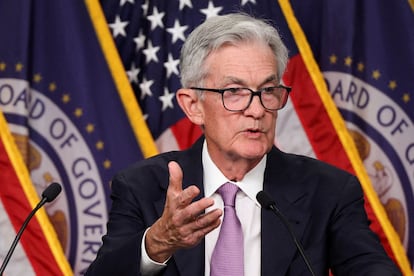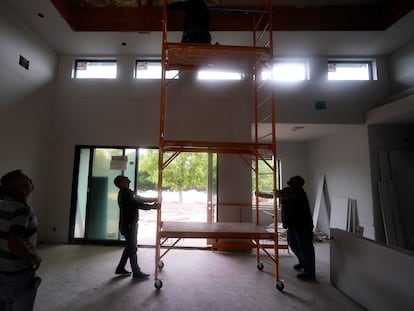Fed chair insists he won’t resign and that Trump can’t force him out
The U.S. central bank sticks to the script and cuts interest rates by 0.25 percentage points


The Federal Reserve stuck to its script on Thursday. In the wake of Donald Trump’s landslide victory in the presidential election, the U.S. central bank reduced interest rates by 0.25 percentage points, as expected, bringing the borrowing cost range down to a range of 4.5%-4.75%.
Fed Chair Jerome Powell firmly stated during a press conference that he would uphold the independence of the central bank, despite threats from Trump. Powell emphasized that he had no intention of resigning, even if asked, and reminded the public that the law protects the Fed’s leadership from being removed by the president before their terms are complete.
Trump presents a threat to the central bank’s independence, which is legally protected. A president cannot simply dismantle it. Most Republicans and Democrats in Congress believe it is beneficial, and Powell — who was first appointed by Trump in 2018 and renewed by Biden — has made it clear that he will not yield to political pressure. The concern, however, may come later. Powell’s term as chair ends on May 15, 2026, while his place on the board ends on January 31, 2028.
In the past, Powell has emphasized the crucial role of the Federal Reserve’s independence in controlling inflation. While Trump has expressed his desire to weigh in on decisions regarding interest rates, Powell has remained firm in his stance. When asked on Thursday if he would resign if requested, Powell answered with a decisive “No.” He reiterated that it is not legally permissible to remove members of the central bank’s board, though he refrained from commenting on other politically sensitive topics, such as whether he feared interference from Trump.
The market is still expecting an additional quarter-point cut in December, but it is beginning to reassess the future trajectory, as the president-elect’s trade and fiscal policies could have inflationary effects and complicate the U.S. economy’s soft landing.
Inflation reached its highest point in four decades during Joe Biden’s presidency. This allowed Trump to capitalize on the discontent of the working class, which has been particularly hard-hit by rising prices. Trump will take office with inflation contained, near the Federal Reserve’s 2% target, but the Fed is not declaring victory yet.
Paradoxically, the core measures of Trump’s program carry inflationary consequences. The tariffs, of course, make imports more expensive. His proposed expansionary fiscal policies, driven by tax cuts, are expected to boost demand. When factoring in the labor market’s supply constraints, driven by his promise of a mass deportation operation, the economic outlook grows more challenging for Powell, as evidenced by the rise in long-term interest rates following the Republican’s victory.
Powell anticipated questions about the election and was prepared with a response, which he read directly from his notes at the lectern. “In the near term, the election will have no effects on our policy decisions,” he stated. This comment was interpreted by the market as an indication that, barring any unexpected developments, the Federal Reserve may implement another quarter-point rate cut in December. Powell made it clear that the Fed would not act preemptively, despite potential challenges from Trump or Congress. He added that the Fed was not ruling out another 0.25-percentage point reduction.
“Many, many things affect the economy, and anyone who writes down forecasts in their job will tell you that the economy is quite difficult to forecast,” Powell said. “We don’t know what the timing and substance of any policy changes will be. We, therefore, don’t know what the effects on the economy would be, specifically whether and to what extent those policies would matter for the achievement of our goal variables, maximum employment and price stability.”
After emphasizing that he did not want to jump to conclusions, Powell acknowledged that the policies of the new administration and the decisions made by Congress could affect the Fed’s mission to achieve price stability and maximum employment. “Along with countless other factors, forecasts of those economic effects would be included in our models of the economy and would be taken into account,” he added.
The Federal Reserve has undertaken its most aggressive interest rate hikes since the 1980s to curb inflation. With inflation relatively under control and employment growth slowing, the Fed believes it has reached an inflection point. In September, it began a cycle of rate cuts, starting with a 0.5-point reduction. Fed members have signaled two more quarter-point cuts for the rest of the year — this one on Thursday and another at the meeting concluding on December 18 — while emphasizing that future moves will depend on incoming data.
Sign up for our weekly newsletter to get more English-language news coverage from EL PAÍS USA Edition
Tu suscripción se está usando en otro dispositivo
¿Quieres añadir otro usuario a tu suscripción?
Si continúas leyendo en este dispositivo, no se podrá leer en el otro.
FlechaTu suscripción se está usando en otro dispositivo y solo puedes acceder a EL PAÍS desde un dispositivo a la vez.
Si quieres compartir tu cuenta, cambia tu suscripción a la modalidad Premium, así podrás añadir otro usuario. Cada uno accederá con su propia cuenta de email, lo que os permitirá personalizar vuestra experiencia en EL PAÍS.
¿Tienes una suscripción de empresa? Accede aquí para contratar más cuentas.
En el caso de no saber quién está usando tu cuenta, te recomendamos cambiar tu contraseña aquí.
Si decides continuar compartiendo tu cuenta, este mensaje se mostrará en tu dispositivo y en el de la otra persona que está usando tu cuenta de forma indefinida, afectando a tu experiencia de lectura. Puedes consultar aquí los términos y condiciones de la suscripción digital.
More information
Archived In
Últimas noticias
What is known about the Interoceanic Train derailment in Oaxaca
Trump turns a Minnesota fraud allegation into ammunition for his MAGA army against Democrats
The year Trump created 1.6 million undocumented immigrants
Russia threatens to break off negotiations after accusing Ukraine of attacking one of Putin’s residences
Most viewed
- Reinhard Genzel, Nobel laureate in physics: ‘One-minute videos will never give you the truth’
- Oona Chaplin: ‘I told James Cameron that I was living in a treehouse and starting a permaculture project with a friend’
- Pablo Escobar’s hippos: A serious environmental problem, 40 years on
- Chevy Chase, the beloved comedian who was a monster off camera: ‘Not everyone hated him, just the people who’ve worked with him’
- Why we lost the habit of sleeping in two segments and how that changed our sense of time










































